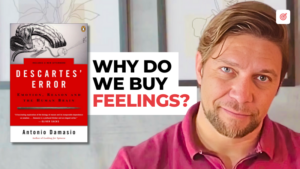✅ FREE ACCESS: Writing For The Web: How to Keep Fast-Readers Laser-Focused
What if your words could transform not just stories but entire destinies?
What if you possess a superpower in the form of writing?
And what if the right words could turn casual readers into passionate followers?
Keep those ‘what if’ questions in mind because today, we’re going to learn how to use the power of copywriting, storytelling, and persuasion to turn leads into loyal customers using 3 copywriting techniques to make sales where most people fail.
But before we get into it, make sure you grant your lifetime access to our free WorkBook: Writing For The Web: How to Keep Fast-Readers Laser-Focused.
This is your chance to attract cost-effective leads and turn them into lifelong customers using only your keyboard powered by AI.
Copywriting For Brands: The Power of Persuasion, Storytelling, and CTAs
In the fast-paced digital landscape, where every word holds the potential for greatness, copywriting can be the difference between blending in or standing out as a brand.
That happens because brands are not just products or services. Brands are stories. The secret to turning leads into loyal customers lies in the words you choose.
To help you not just survive but thrive in this digital landscape, we will explore 3 simple and effective Copywriting tips For Brands that most people ignore or get wrong.
- Crafting Magnetic Brand Stories: Revealing how copywriting and storytelling make brands unforgettable.
- The Psychology of Persuasion: Exploring the subconscious and emotional triggers that captivate audiences.
- The Art of Crafting Irresistible CTAs: Mastering the CTAs that bridge the gap between words and actions.
Crafting Magnetic Brand Stories
The first of 3 tips of copywriting for brands is Crafting Magnetic Brand Stories.
In the realm of copywriting for brands, storytelling is your most powerful weapon.
Your brand is not just a name; it’s a story waiting to be told. It’s about connecting with your audience on an emotional level.
Why does that matter the most?
Because our subconscious mind doesn’t speak language, it speaks emotions.
If you try to sell something on a rational level, prospects can use language to argue against your sales pitch.
But if you try to sell something on an emotional level, prospects can’t just stop feeling in the way that makes sense to them.
That emotional connection is what differentiates businesses from brands. If you want to be a brand, you have to become a story.
The Power of Brand Archetypes
One approach to crafting magnetic brand stories is by exploring brand archetypes.
Archetypes are universal symbols and themes that resonate with people on a fundamental and emotional level.
Let’s look at Apple as a prime example.
They’ve mastered the art of storytelling by consistently portraying themselves as the Rebel archetype.
They challenge the status quo, encourage us to “Think Different,” and position themselves as the innovative underdogs.
This not only makes their brand more relatable but also creates a lasting impression.
The Psychology of Persuasion
The second of 3 tips of copywriting for brands is The Psychology of Persuasion.
In the book Influence: The Psychology of Persuasion, Dr. Robert Cialdini identifies six principles of persuasion.
Incorporating these principles into your copy can be a game-changer.
Let’s take a look at 2 of those principles.
1) Reciprocity
When someone does something for us, we feel compelled to do something in return.
In the world of business, this principle can be harnessed by offering something valuable to your audience before asking for anything in return.
How can you accomplish that with copywriting?
Consider the concept of lead magnets.
By providing a free e-book, template, or valuable resource, you initiate a cycle of reciprocity.
Your audience is more likely to give back by taking the desired action—whether it’s making a purchase or signing up for your newsletter.
2) Commitment and Consistency
That means, once people commit to something, they are more likely to follow through with related actions.
In your copywriting pieces, you can encourage small commitments that align with your brand’s goals.
For instance, getting your audience to subscribe to your newsletter is a small commitment in return for something valuable.
Once they’ve taken that step, they are more likely to engage further with your brand, such as making a purchase.
When developing products and sales funnels, the first thing you have to have clear is the story you will tell and which commitments you will ask your audience in resonance to that story incrementally.
That will pave the way for upsells, downfalls, and cross-sells, for example.
The Art of Crafting Irresistible CTAs
The last of 3 tips of copywriting for brands is The Art of Crafting Irresistible CTAs.
Effective CTAs begin with a deep understanding of your audience and the moment of their relationship with your brand.
Before writing a single letter, ask yourself:
What does my audience need at this moment in time based on the value I provided so far, and the next steps toward their meaningful pursuit?
Your CTA should sound like a natural progression in the reader’s journey.
Writing Based Urgency and Scarcity
Another aspect that’s crucial to CTAs is urgency and scarcity.
A call to action that doesn’t convey urgency and scarcity is not a call to action because people take action to either flee from something terrible or to find something valuable.
That’s urgent and scarce by definition.
How to add urgency and scarcity to your copy? Simply write in a way that your offer is scarce in relationship with one of these 3 aspects:
- Time
- Units
- Requirements
But be careful…
It’s essential to use these tactics honestly. If you say “Few Seats Available” or “Last Call”you better carry that out.
Misleading your audience can and will damage your reputation.
Writing A/B Tests for CTA Optimization
Last but not least, you should write A/B tests for your CTAs.
Just in case you’ve never heard of A/B testing before…
A/B testing is a method where you compare two different versions of a piece of copy to see which one performs better based on audience engagement.
It’s a data-driven approach to fine-tune your copy and maximize conversion rates.
But do you know what’s the most powerful thing about A/B testing everything you can?
When you A/B test your copywriting pieces, like titles and CTAs, you’re shifting from a position of assuming what works best for your audience to letting them tell you what works best for themselves.
Knowing that you can make a difference from cents to abundance just by picking words is mind-boggling.
In the Writing For The Web Workbook, you will learn the 3-Part Content Framework to attract cost-effective leads and turn them into lifelong customers using only your keyboard powered by AI.
By granting your free lifetime access to this workbook today, you will not only master the art of copywriting for brands but also, have access to all future updates at no cost.
The link is the description.




